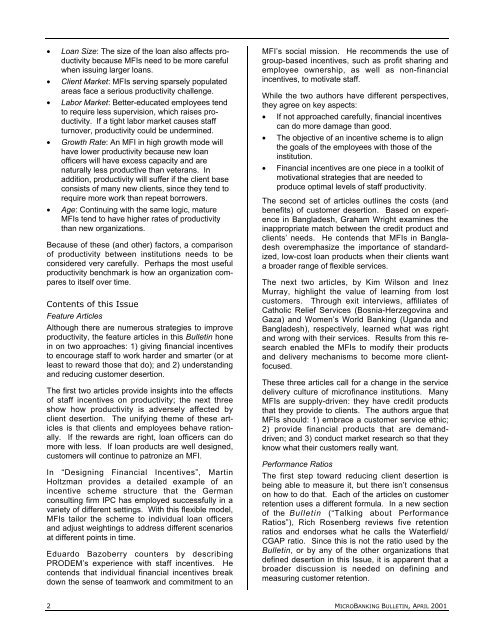the microbanking bulletin - Microfinance Information Exchange
the microbanking bulletin - Microfinance Information Exchange
the microbanking bulletin - Microfinance Information Exchange
Create successful ePaper yourself
Turn your PDF publications into a flip-book with our unique Google optimized e-Paper software.
• Loan Size: The size of <strong>the</strong> loan also affects productivitybecause MFIs need to be more carefulwhen issuing larger loans.• Client Market: MFIs serving sparsely populatedareas face a serious productivity challenge.• Labor Market: Better-educated employees tendto require less supervision, which raises productivity.If a tight labor market causes staffturnover, productivity could be undermined.• Growth Rate: An MFI in high growth mode willhave lower productivity because new loanofficers will have excess capacity and arenaturally less productive than veterans. Inaddition, productivity will suffer if <strong>the</strong> client baseconsists of many new clients, since <strong>the</strong>y tend torequire more work than repeat borrowers.• Age: Continuing with <strong>the</strong> same logic, matureMFIs tend to have higher rates of productivitythan new organizations.Because of <strong>the</strong>se (and o<strong>the</strong>r) factors, a comparisonof productivity between institutions needs to beconsidered very carefully. Perhaps <strong>the</strong> most usefulproductivity benchmark is how an organization comparesto itself over time.Contents of this IssueFeature ArticlesAlthough <strong>the</strong>re are numerous strategies to improveproductivity, <strong>the</strong> feature articles in this Bulletin honein on two approaches: 1) giving financial incentivesto encourage staff to work harder and smarter (or atleast to reward those that do); and 2) understandingand reducing customer desertion.The first two articles provide insights into <strong>the</strong> effectsof staff incentives on productivity; <strong>the</strong> next threeshow how productivity is adversely affected byclient desertion. The unifying <strong>the</strong>me of <strong>the</strong>se articlesis that clients and employees behave rationally.If <strong>the</strong> rewards are right, loan officers can domore with less. If loan products are well designed,customers will continue to patronize an MFI.In “Designing Financial Incentives”, MartinHoltzman provides a detailed example of anincentive scheme structure that <strong>the</strong> Germanconsulting firm IPC has employed successfully in avariety of different settings. With this flexible model,MFIs tailor <strong>the</strong> scheme to individual loan officersand adjust weightings to address different scenariosat different points in time.Eduardo Bazoberry counters by describingPRODEM’s experience with staff incentives. Hecontends that individual financial incentives breakdown <strong>the</strong> sense of teamwork and commitment to anMFI’s social mission. He recommends <strong>the</strong> use ofgroup-based incentives, such as profit sharing andemployee ownership, as well as non-financialincentives, to motivate staff.While <strong>the</strong> two authors have different perspectives,<strong>the</strong>y agree on key aspects:• If not approached carefully, financial incentivescan do more damage than good.• The objective of an incentive scheme is to align<strong>the</strong> goals of <strong>the</strong> employees with those of <strong>the</strong>institution.• Financial incentives are one piece in a toolkit ofmotivational strategies that are needed toproduce optimal levels of staff productivity.The second set of articles outlines <strong>the</strong> costs (andbenefits) of customer desertion. Based on experiencein Bangladesh, Graham Wright examines <strong>the</strong>inappropriate match between <strong>the</strong> credit product andclients’ needs. He contends that MFIs in Bangladeshoveremphasize <strong>the</strong> importance of standardized,low-cost loan products when <strong>the</strong>ir clients wanta broader range of flexible services.The next two articles, by Kim Wilson and InezMurray, highlight <strong>the</strong> value of learning from lostcustomers. Through exit interviews, affiliates ofCatholic Relief Services (Bosnia-Herzegovina andGaza) and Women’s World Banking (Uganda andBangladesh), respectively, learned what was rightand wrong with <strong>the</strong>ir services. Results from this researchenabled <strong>the</strong> MFIs to modify <strong>the</strong>ir productsand delivery mechanisms to become more clientfocused.These three articles call for a change in <strong>the</strong> servicedelivery culture of microfinance institutions. ManyMFIs are supply-driven: <strong>the</strong>y have credit productsthat <strong>the</strong>y provide to clients. The authors argue thatMFIs should: 1) embrace a customer service ethic;2) provide financial products that are demanddriven;and 3) conduct market research so that <strong>the</strong>yknow what <strong>the</strong>ir customers really want.Performance RatiosThe first step toward reducing client desertion isbeing able to measure it, but <strong>the</strong>re isn’t consensuson how to do that. Each of <strong>the</strong> articles on customerretention uses a different formula. In a new sectionof <strong>the</strong> Bulletin (“Talking about PerformanceRatios”), Rich Rosenberg reviews five retentionratios and endorses what he calls <strong>the</strong> Waterfield/CGAP ratio. Since this is not <strong>the</strong> ratio used by <strong>the</strong>Bulletin, or by any of <strong>the</strong> o<strong>the</strong>r organizations thatdefined desertion in this Issue, it is apparent that abroader discussion is needed on defining andmeasuring customer retention.2 MICROBANKING BULLETIN, APRIL 2001
















